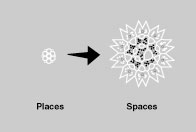FROM PLACES TO SPACES
People will inhabit places…
but increasingly the economy inhabits a space.
A place is bounded by four dimensions. For two things to be adjacent, they must be close to each other on one of four axes: up/down, left/right, back/forth (x, y, z), and time. As rich as physical places are (and we still don’t appreciate how rich they can be), they limit the number of connections that entities can make within them. A person in a place can only interact with a fixed and rather small number of other people in the same vicinity. Artifacts can touch only the other artifacts in close proximity.
A space, unlike a place, is an electronically created environment. It is where more and more of the economy happens. Unlike place, space has unlimited dimensions. Entities (people, objects, agents, bits, nodes, etc.) can be adjacent in a thousand different ways and a thousand different directions. A person in an electronic space can communicate to 10 million people at once, or interact in a game with 20,000 others–things that would be impossible in physical space. An automobile can be linked in hundreds of directions–to other cars stuck in traffic miles away, environmental monitors, satellite navigation antennas, toll collectors, and the manufacturer’s engine-performance center. In physical place a car can only interact with those within braking distance of its front and rear bumpers.

The invention of communication allowed life to evolve from globular organisms into fantastic beings, just as networks allow place-based firms to blossom into fantastic spaces.

